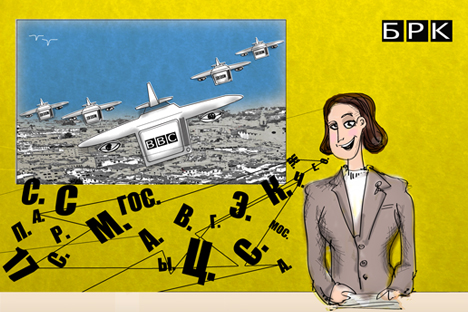
Click to enlarge the cartoon. Drawing by Niyaz Karim
Immediately following the Bolshevik revolution of 1917, Russia ceased to be called Russia, and was renamed the RSFSR or Russian Soviet Federative Socialist Republic. However, Russian émigrés refused to accept this change and mockingly referred to it as “Sovdepia”, a combination of the words “Deputy” and “Soviet”, which alluded to the governing body of the RSFSR, the Soviet (or Council) of Deputies. After the establishment of Soviet rule in the Caucasus and Central Asia, several other republics were added to the RSFSR, and the country became known as the USSR, or Union of Soviet Socialist Republics. This name remained in use until 1991, when the USSR broke up into fifteen independent states.
Following the dissolution of the USSR, Russia once again took on its traditional name. However, the term Russian Federation (or RF) is also considered acceptable. The former Soviet states also periodically form various alliances known under other acronyms; these include the CIS (Commonwealth of Independent States) and the recently founded EAEC (Eurasian Economic Community).
Some international acronyms are used in Russian without translation; examples include NATO and the BBC, which if translated into Russian would be abbreviated as BRK. Curiously, if the abbreviation BBC is read in Cyrillic, it becomes an acronym used to refer to the Russian Air Force (Voyenno-Vozdushnye Sily Rossii).
Acronyms are also traditionally used to refer to political parties. The USSR had only one political party, the CPSU, or the Communist Party of the Soviet Union. However, until the early 1950s, it was called the AUCP(B), or the All-Union Communist Party (Bolsheviks)
The first “alternative” political party during the Perestroika years was the LDPR or the Liberal Democratic Party of Russia, while one of the modern political parties, the People’s Freedom Party, is known by its Russian syllabic abbreviation PARNAS.
In 1917 the All-Russian Emergency Commission for Combating Counter-Revolution and Sabotage, abbreviated as the VChK or simply ChK, was formed. Its workers soon became known as “Chekists” after the abbreviated title of the commission, which even in English took its name (the Cheka) directly from the acronym. Subsequently this oppressive agency was renamed multiple times, and was known as the NKVD (People’s Commissariat of Internal Affairs), MGB (Ministry for State Security), and most famously the KGB (Committee for State Security). In modern Russia, the FSB (Federal Security Service) has taken on the KGB’s responsibilities. Interestingly, almost a century later, FSB officers are sometimes still referred to as Chekists.
Following the publication of Alexander Solzhenitsyn’s Gulag Archipelago in the 1970s, the acronym GULAG (Main Camp Administration) became known the world over. We must note that only the first three letters of this acronym stand for abbreviated words; the last three letters are actually all part of the abbreviation for the Russian word “camp” (лагерь). Another acronym which became well-known at that time was “zek”, which is short for the Russian word for “inmate” (заключённый) and was used to describe people serving time in the camps. Meanwhile, the main Soviet counterintelligence force during WWII was named SMERSH, a syllabic of abbreviation of the Russian phrase “death to spies” (смерть шпионам).
In modern Russia, the letters GB have lost their terrifying association with the acronym KGB. For example, today the enormous Russian State Library, which is located beside the Kremlin, is known as the RGB. It was previously known as the V.I. Lenin Library (Библиотека имени В.И. Ленина), but has long been renamed. Curiously, the nearest Moscow subway station, which was built back in the 1930s, still bears the former name of the library, Biblioteka Imeni Lenina.
The name of another subway station, meanwhile, has undergone a paradoxical metamorphosis. In 1939 the All-Union Agricultural Expo Centre or VSKhV was opened in northern Moscow, and when the subway line was extended there in the 1950s, the nearest station was given the same name. Shortly afterwards the expo centre and the subway station were renamed the Exhibition Centre of the Achievements of the National Economy, or VDNKh. After the collapse of the USSR the centre no longer served an ideological purpose and became a regular trade center named the All-Russia Exhibition Centre, or VVTs. However, the station was not renamed, and over time its name became synonymous with the surrounding city district. Consequently, in order to get to VVTs you must first go to VDNKh.
All rights reserved by Rossiyskaya Gazeta.
Subscribe
to our newsletter!
Get the week's best stories straight to your inbox